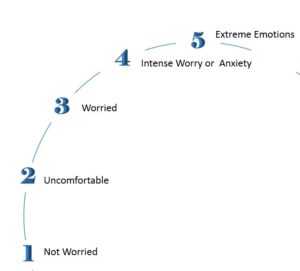Much like the roller-coasters I fear, feelings of worry and anxiety go up and go down. As you and your child or teen address her worry and anxiety, it is important to consider the intensity of her feelings. The strength of her anxiety drives what will work to calm her fears.
The Anxiety Arc
Anxiety’s progression can be broken down into five stages on what I call the “AnxietyArc”

-
At the lowest point of the arc, we’re not worried.
-
When faced with some “danger” whether real or imagined, we start to feel uncomfortable.
-
Uncomfortableness left unquestioned can progress to worry.
-
An unaddressed worry can progress to intense anxiety.
-
Finally, at the highest point in the arc, we experience extreme emotions and “fight or flight” symptoms.
Sometimes the progression of anxiety is slow, while other times it can be super-fast.
Addressing Anxiety
What you can do to address worry or anxiety depends on the intensity of your (or your child’s) feelings. In other words, where you are on the arc drives what you can do to help yourself.
Although problem-solving and realistic thinking can result in the biggest improvements, in the long run, it is impossible to do these when experiencing intense anxiety or extreme emotions.
The sooner you can start to address feelings of worry, the better. Try these strategies at each level.
(5) Extreme Emotions: Try Self-Calming
When experiencing extreme emotions (5), self-calming is best. For your child or teen, that means calming himself. Anything that a parent does at this point will typically only make things worse. Teach your child to breathe deeply from the diaphragm, squeeze his hands, or squeeze the muscles in his arms to fight off his anxiety.
(4) Intense Worry or Anxiety: Use Distress Tolerance Strategies (Distractions)
When struggling with intense worry or anxiety (4), it can be helpful for you or your child to distract yourself. These strategies are designed to help you tolerate stressful times instead of doing something that you might regret later.
-
Do something! Go for a walk, run, dance, hold a piece of ice as long as you can, or engage in some other activity you enjoy.
-
Distract yourself by comparing what’s going well to your current struggles or how much better you are doing now compared to in the past.
-
Do something to create an emotion that is the opposite of anxiety (listen to music, watch funny videos, or read a joke book).
-
Try to temporarily push the worry out of your mind. For example, if you have trouble getting to sleep because of worry, write down each anxious concern and two or three things you’ll do tomorrow to address it. When you start worrying again, tell yourself you have a plan.
-
Stop your worrying thoughts by doing any thinking task: read, do number/word puzzles, or even count (books in a bookcase, tiles on the floor, colors in a puzzle, or anything else that you see).
-
Pay attention to your senses: Pet your dog, look at art, or listen to sounds in nature.
(3) Worried: Think Realistically
When feeling worried (3), it can be helpful to recognize the automatic negative thoughts or beliefs behind your worry, and then strive to change those thoughts. The only real way to change the feeling is to change the thought.
-
First, identify the problem causing your anxiety.
-
Next, figure out the negative thought or beliefs you have about the problem or your ability to handle the problem. Usually, this thought includes the words I, me, or my.
-
Finally, ask some questions to look for evidence and alternatives to your negative thought including, “Is this thought true? What’s happened when I’ve worried about this before?, What usually happens to other people in this situation?, What is most likely to happen?, and What’s my best thought?”
-
Over time, you or your child can learn to develop questions for yourselves based on the type of unrealistic thoughts you have (All-or-nothing, exaggerating, over-generalizing, labeling, negative filtering, etc.)*
By changing unrealistic thoughts, you can make the biggest changes in your feelings of anxiety and fear over time.
(2) Feeling Uncomfortable: Try Problem-Solving
When you or your child are starting to feel uncomfortable (2), try to solve the anxiety-provoking problem. Ask questions like, “What is the problem?” and “What is causing the problem?” to better identify what’s troubling your child. Once you have identified the problem, ask these questions to try to solve it:
-
What can you change about the problem (or its causes)?
-
How can you change your focus on the problem?
-
How can you change your thinking about the problem? (Try thinking realistically.)
-
How can you change your actions? (Take action to address the problem instead of fighting, fleeing, or freezing.)

